A Detailed Report on Banking Systems: Types, Functions, and Value
VerifiedAdded on 2023/03/31
|8
|1933
|68
Report
AI Summary
This report provides a comprehensive overview of various banking systems, including merchant banks, commercial banks, investment banks, corporate banks, postal savings banks, cooperative banks, retail banks, and construction banks. It details the key operations, target clients, and profit-making strategies of each type of bank. The report also touches upon the benefits of digital banking for each system, highlighting examples of banks that have successfully integrated digital solutions. It explains how merchant banks serve large corporations, commercial banks cater to the general public and small businesses, and investment banks facilitate complex financial transactions. Furthermore, the report discusses the role of cooperative banks in supporting farmers and small entrepreneurs, the focus of retail banks on individual customers, and the unique function of postal savings banks in promoting thrift among the underprivileged. Finally, it touches upon the international utilities of construction banks.
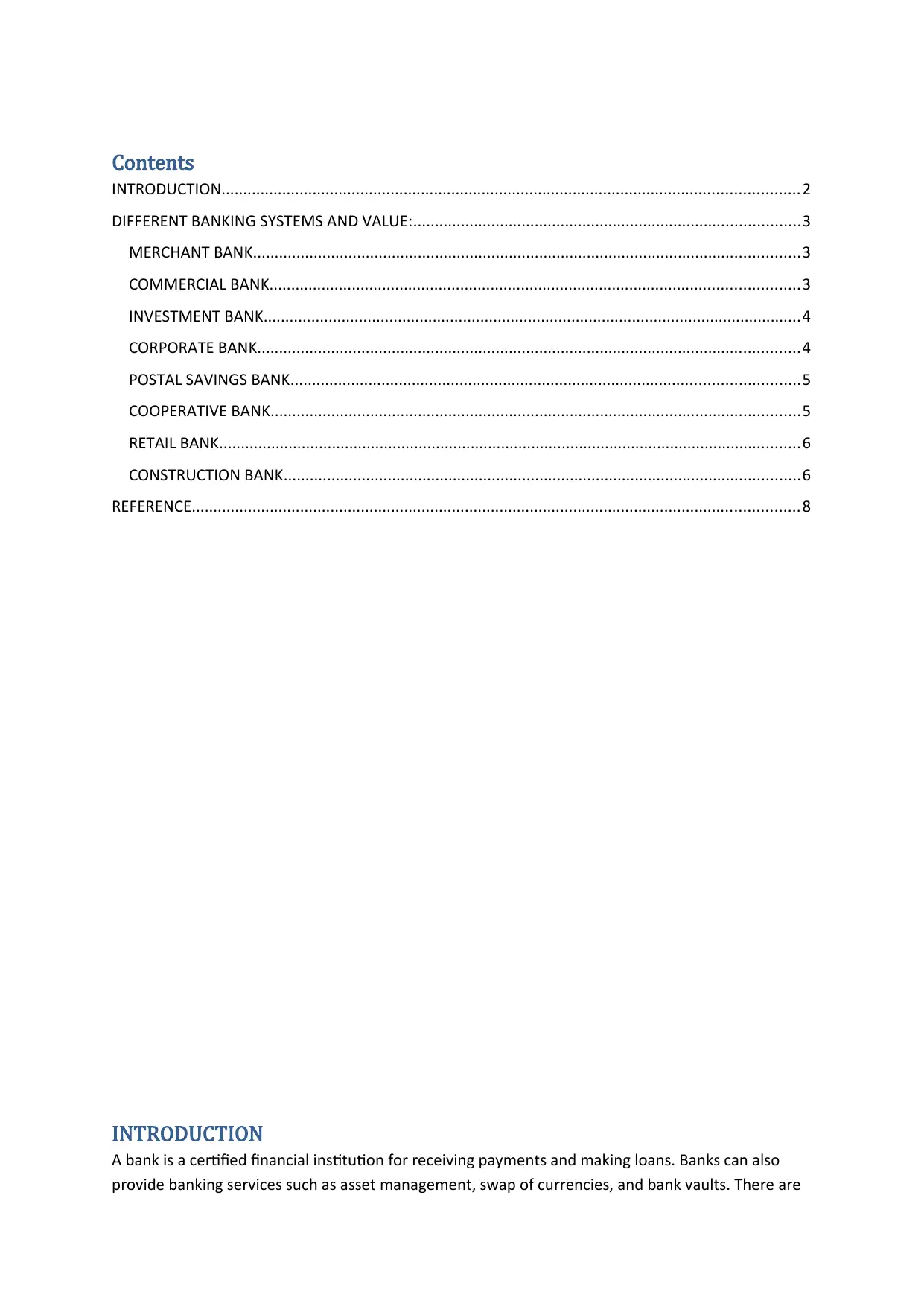
Contents
INTRODUCTION.....................................................................................................................................2
DIFFERENT BANKING SYSTEMS AND VALUE:.........................................................................................3
MERCHANT BANK..............................................................................................................................3
COMMERCIAL BANK..........................................................................................................................3
INVESTMENT BANK............................................................................................................................4
CORPORATE BANK.............................................................................................................................4
POSTAL SAVINGS BANK.....................................................................................................................5
COOPERATIVE BANK..........................................................................................................................5
RETAIL BANK......................................................................................................................................6
CONSTRUCTION BANK.......................................................................................................................6
REFERENCE............................................................................................................................................8
INTRODUCTION
A bank is a certified financial institution for receiving payments and making loans. Banks can also
provide banking services such as asset management, swap of currencies, and bank vaults. There are
INTRODUCTION.....................................................................................................................................2
DIFFERENT BANKING SYSTEMS AND VALUE:.........................................................................................3
MERCHANT BANK..............................................................................................................................3
COMMERCIAL BANK..........................................................................................................................3
INVESTMENT BANK............................................................................................................................4
CORPORATE BANK.............................................................................................................................4
POSTAL SAVINGS BANK.....................................................................................................................5
COOPERATIVE BANK..........................................................................................................................5
RETAIL BANK......................................................................................................................................6
CONSTRUCTION BANK.......................................................................................................................6
REFERENCE............................................................................................................................................8
INTRODUCTION
A bank is a certified financial institution for receiving payments and making loans. Banks can also
provide banking services such as asset management, swap of currencies, and bank vaults. There are
Paraphrase This Document
Need a fresh take? Get an instant paraphrase of this document with our AI Paraphraser
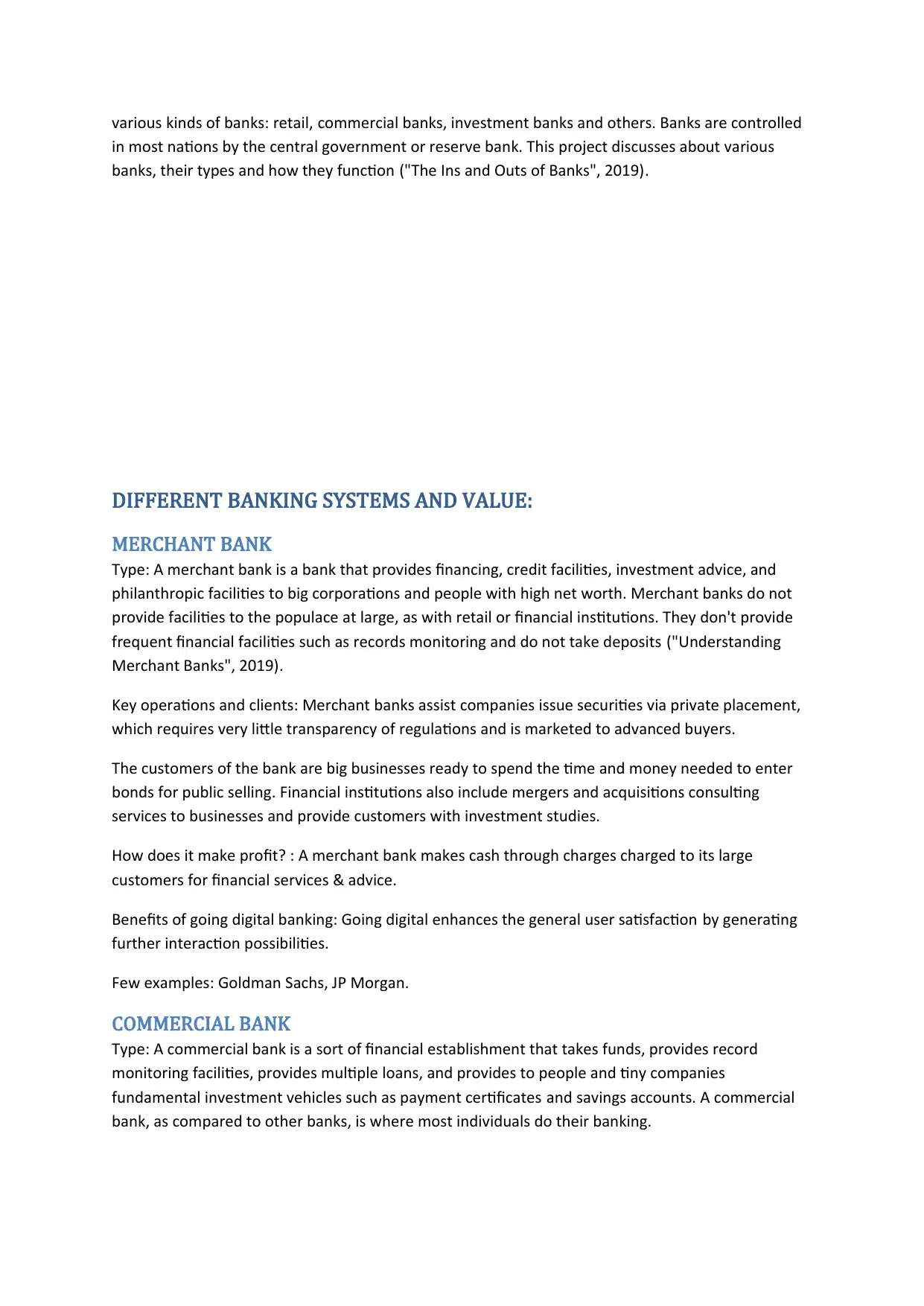
various kinds of banks: retail, commercial banks, investment banks and others. Banks are controlled
in most nations by the central government or reserve bank. This project discusses about various
banks, their types and how they function ("The Ins and Outs of Banks", 2019).
DIFFERENT BANKING SYSTEMS AND VALUE:
MERCHANT BANK
Type: A merchant bank is a bank that provides financing, credit facilities, investment advice, and
philanthropic facilities to big corporations and people with high net worth. Merchant banks do not
provide facilities to the populace at large, as with retail or financial institutions. They don't provide
frequent financial facilities such as records monitoring and do not take deposits ("Understanding
Merchant Banks", 2019).
Key operations and clients: Merchant banks assist companies issue securities via private placement,
which requires very little transparency of regulations and is marketed to advanced buyers.
The customers of the bank are big businesses ready to spend the time and money needed to enter
bonds for public selling. Financial institutions also include mergers and acquisitions consulting
services to businesses and provide customers with investment studies.
How does it make profit? : A merchant bank makes cash through charges charged to its large
customers for financial services & advice.
Benefits of going digital banking: Going digital enhances the general user satisfaction by generating
further interaction possibilities.
Few examples: Goldman Sachs, JP Morgan.
COMMERCIAL BANK
Type: A commercial bank is a sort of financial establishment that takes funds, provides record
monitoring facilities, provides multiple loans, and provides to people and tiny companies
fundamental investment vehicles such as payment certificates and savings accounts. A commercial
bank, as compared to other banks, is where most individuals do their banking.
in most nations by the central government or reserve bank. This project discusses about various
banks, their types and how they function ("The Ins and Outs of Banks", 2019).
DIFFERENT BANKING SYSTEMS AND VALUE:
MERCHANT BANK
Type: A merchant bank is a bank that provides financing, credit facilities, investment advice, and
philanthropic facilities to big corporations and people with high net worth. Merchant banks do not
provide facilities to the populace at large, as with retail or financial institutions. They don't provide
frequent financial facilities such as records monitoring and do not take deposits ("Understanding
Merchant Banks", 2019).
Key operations and clients: Merchant banks assist companies issue securities via private placement,
which requires very little transparency of regulations and is marketed to advanced buyers.
The customers of the bank are big businesses ready to spend the time and money needed to enter
bonds for public selling. Financial institutions also include mergers and acquisitions consulting
services to businesses and provide customers with investment studies.
How does it make profit? : A merchant bank makes cash through charges charged to its large
customers for financial services & advice.
Benefits of going digital banking: Going digital enhances the general user satisfaction by generating
further interaction possibilities.
Few examples: Goldman Sachs, JP Morgan.
COMMERCIAL BANK
Type: A commercial bank is a sort of financial establishment that takes funds, provides record
monitoring facilities, provides multiple loans, and provides to people and tiny companies
fundamental investment vehicles such as payment certificates and savings accounts. A commercial
bank, as compared to other banks, is where most individuals do their banking.
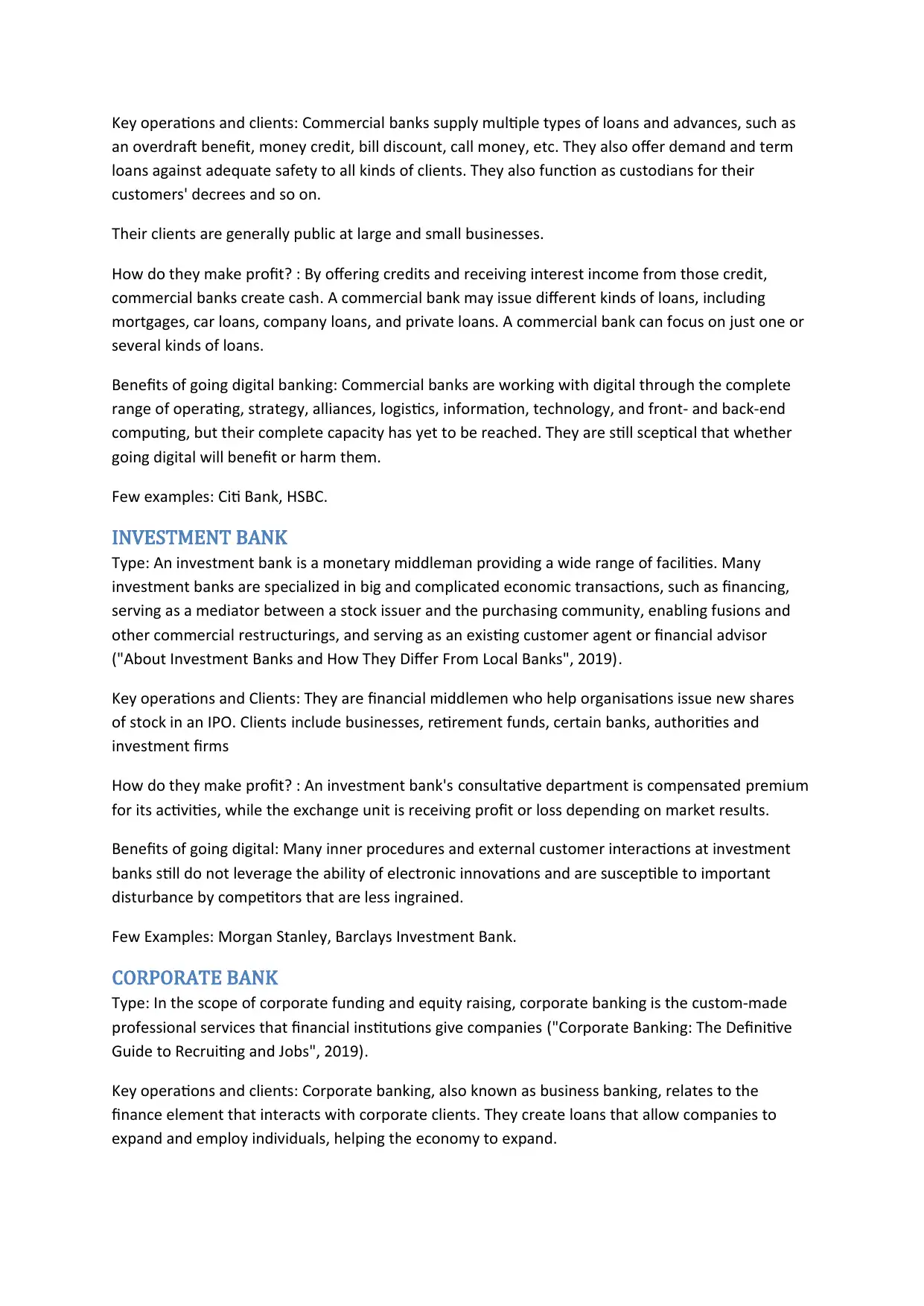
Key operations and clients: Commercial banks supply multiple types of loans and advances, such as
an overdraft benefit, money credit, bill discount, call money, etc. They also offer demand and term
loans against adequate safety to all kinds of clients. They also function as custodians for their
customers' decrees and so on.
Their clients are generally public at large and small businesses.
How do they make profit? : By offering credits and receiving interest income from those credit,
commercial banks create cash. A commercial bank may issue different kinds of loans, including
mortgages, car loans, company loans, and private loans. A commercial bank can focus on just one or
several kinds of loans.
Benefits of going digital banking: Commercial banks are working with digital through the complete
range of operating, strategy, alliances, logistics, information, technology, and front- and back-end
computing, but their complete capacity has yet to be reached. They are still sceptical that whether
going digital will benefit or harm them.
Few examples: Citi Bank, HSBC.
INVESTMENT BANK
Type: An investment bank is a monetary middleman providing a wide range of facilities. Many
investment banks are specialized in big and complicated economic transactions, such as financing,
serving as a mediator between a stock issuer and the purchasing community, enabling fusions and
other commercial restructurings, and serving as an existing customer agent or financial advisor
("About Investment Banks and How They Differ From Local Banks", 2019).
Key operations and Clients: They are financial middlemen who help organisations issue new shares
of stock in an IPO. Clients include businesses, retirement funds, certain banks, authorities and
investment firms
How do they make profit? : An investment bank's consultative department is compensated premium
for its activities, while the exchange unit is receiving profit or loss depending on market results.
Benefits of going digital: Many inner procedures and external customer interactions at investment
banks still do not leverage the ability of electronic innovations and are susceptible to important
disturbance by competitors that are less ingrained.
Few Examples: Morgan Stanley, Barclays Investment Bank.
CORPORATE BANK
Type: In the scope of corporate funding and equity raising, corporate banking is the custom-made
professional services that financial institutions give companies ("Corporate Banking: The Definitive
Guide to Recruiting and Jobs", 2019).
Key operations and clients: Corporate banking, also known as business banking, relates to the
finance element that interacts with corporate clients. They create loans that allow companies to
expand and employ individuals, helping the economy to expand.
an overdraft benefit, money credit, bill discount, call money, etc. They also offer demand and term
loans against adequate safety to all kinds of clients. They also function as custodians for their
customers' decrees and so on.
Their clients are generally public at large and small businesses.
How do they make profit? : By offering credits and receiving interest income from those credit,
commercial banks create cash. A commercial bank may issue different kinds of loans, including
mortgages, car loans, company loans, and private loans. A commercial bank can focus on just one or
several kinds of loans.
Benefits of going digital banking: Commercial banks are working with digital through the complete
range of operating, strategy, alliances, logistics, information, technology, and front- and back-end
computing, but their complete capacity has yet to be reached. They are still sceptical that whether
going digital will benefit or harm them.
Few examples: Citi Bank, HSBC.
INVESTMENT BANK
Type: An investment bank is a monetary middleman providing a wide range of facilities. Many
investment banks are specialized in big and complicated economic transactions, such as financing,
serving as a mediator between a stock issuer and the purchasing community, enabling fusions and
other commercial restructurings, and serving as an existing customer agent or financial advisor
("About Investment Banks and How They Differ From Local Banks", 2019).
Key operations and Clients: They are financial middlemen who help organisations issue new shares
of stock in an IPO. Clients include businesses, retirement funds, certain banks, authorities and
investment firms
How do they make profit? : An investment bank's consultative department is compensated premium
for its activities, while the exchange unit is receiving profit or loss depending on market results.
Benefits of going digital: Many inner procedures and external customer interactions at investment
banks still do not leverage the ability of electronic innovations and are susceptible to important
disturbance by competitors that are less ingrained.
Few Examples: Morgan Stanley, Barclays Investment Bank.
CORPORATE BANK
Type: In the scope of corporate funding and equity raising, corporate banking is the custom-made
professional services that financial institutions give companies ("Corporate Banking: The Definitive
Guide to Recruiting and Jobs", 2019).
Key operations and clients: Corporate banking, also known as business banking, relates to the
finance element that interacts with corporate clients. They create loans that allow companies to
expand and employ individuals, helping the economy to expand.
⊘ This is a preview!⊘
Do you want full access?
Subscribe today to unlock all pages.

Trusted by 1+ million students worldwide
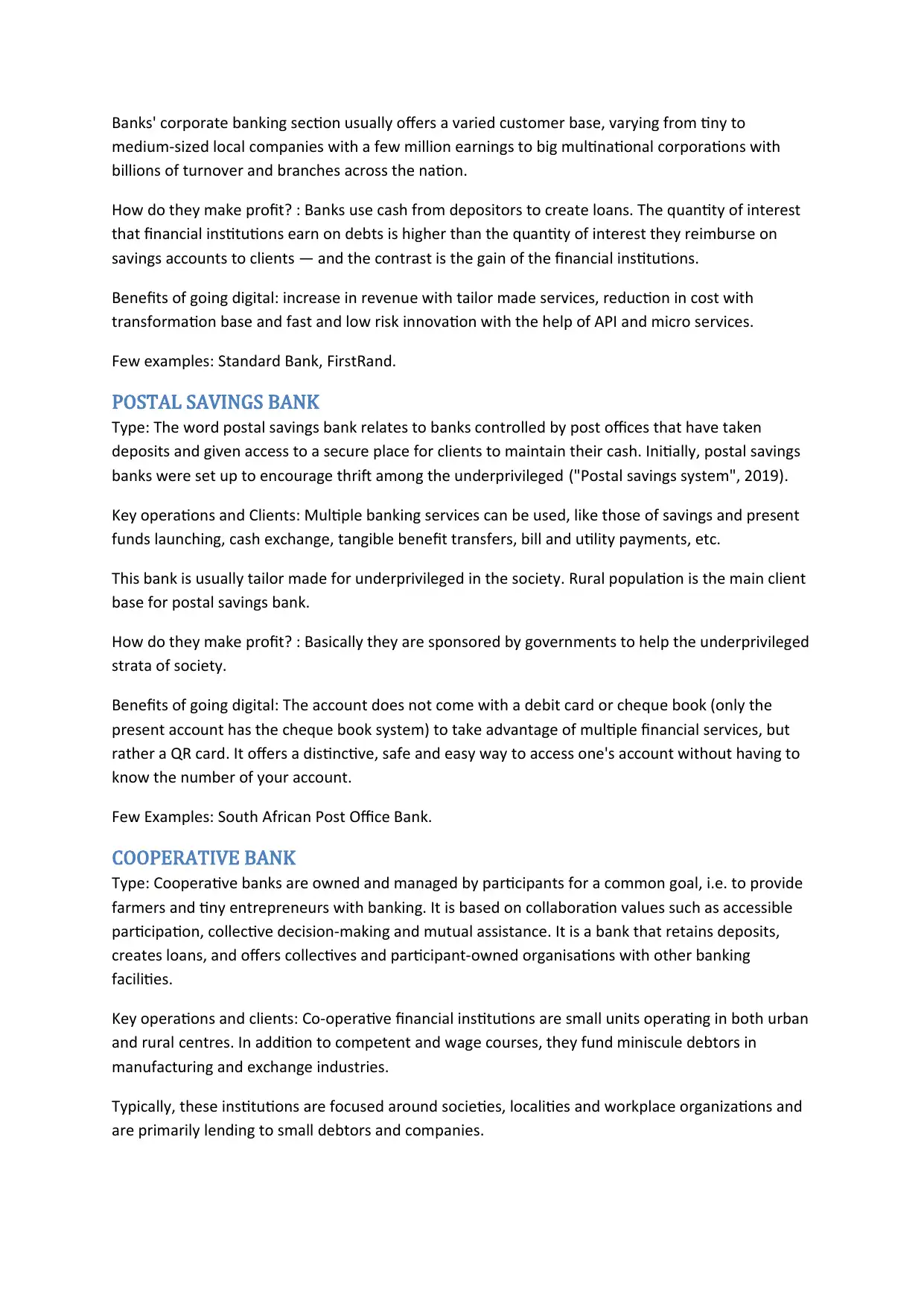
Banks' corporate banking section usually offers a varied customer base, varying from tiny to
medium-sized local companies with a few million earnings to big multinational corporations with
billions of turnover and branches across the nation.
How do they make profit? : Banks use cash from depositors to create loans. The quantity of interest
that financial institutions earn on debts is higher than the quantity of interest they reimburse on
savings accounts to clients — and the contrast is the gain of the financial institutions.
Benefits of going digital: increase in revenue with tailor made services, reduction in cost with
transformation base and fast and low risk innovation with the help of API and micro services.
Few examples: Standard Bank, FirstRand.
POSTAL SAVINGS BANK
Type: The word postal savings bank relates to banks controlled by post offices that have taken
deposits and given access to a secure place for clients to maintain their cash. Initially, postal savings
banks were set up to encourage thrift among the underprivileged ("Postal savings system", 2019).
Key operations and Clients: Multiple banking services can be used, like those of savings and present
funds launching, cash exchange, tangible benefit transfers, bill and utility payments, etc.
This bank is usually tailor made for underprivileged in the society. Rural population is the main client
base for postal savings bank.
How do they make profit? : Basically they are sponsored by governments to help the underprivileged
strata of society.
Benefits of going digital: The account does not come with a debit card or cheque book (only the
present account has the cheque book system) to take advantage of multiple financial services, but
rather a QR card. It offers a distinctive, safe and easy way to access one's account without having to
know the number of your account.
Few Examples: South African Post Office Bank.
COOPERATIVE BANK
Type: Cooperative banks are owned and managed by participants for a common goal, i.e. to provide
farmers and tiny entrepreneurs with banking. It is based on collaboration values such as accessible
participation, collective decision-making and mutual assistance. It is a bank that retains deposits,
creates loans, and offers collectives and participant-owned organisations with other banking
facilities.
Key operations and clients: Co-operative financial institutions are small units operating in both urban
and rural centres. In addition to competent and wage courses, they fund miniscule debtors in
manufacturing and exchange industries.
Typically, these institutions are focused around societies, localities and workplace organizations and
are primarily lending to small debtors and companies.
medium-sized local companies with a few million earnings to big multinational corporations with
billions of turnover and branches across the nation.
How do they make profit? : Banks use cash from depositors to create loans. The quantity of interest
that financial institutions earn on debts is higher than the quantity of interest they reimburse on
savings accounts to clients — and the contrast is the gain of the financial institutions.
Benefits of going digital: increase in revenue with tailor made services, reduction in cost with
transformation base and fast and low risk innovation with the help of API and micro services.
Few examples: Standard Bank, FirstRand.
POSTAL SAVINGS BANK
Type: The word postal savings bank relates to banks controlled by post offices that have taken
deposits and given access to a secure place for clients to maintain their cash. Initially, postal savings
banks were set up to encourage thrift among the underprivileged ("Postal savings system", 2019).
Key operations and Clients: Multiple banking services can be used, like those of savings and present
funds launching, cash exchange, tangible benefit transfers, bill and utility payments, etc.
This bank is usually tailor made for underprivileged in the society. Rural population is the main client
base for postal savings bank.
How do they make profit? : Basically they are sponsored by governments to help the underprivileged
strata of society.
Benefits of going digital: The account does not come with a debit card or cheque book (only the
present account has the cheque book system) to take advantage of multiple financial services, but
rather a QR card. It offers a distinctive, safe and easy way to access one's account without having to
know the number of your account.
Few Examples: South African Post Office Bank.
COOPERATIVE BANK
Type: Cooperative banks are owned and managed by participants for a common goal, i.e. to provide
farmers and tiny entrepreneurs with banking. It is based on collaboration values such as accessible
participation, collective decision-making and mutual assistance. It is a bank that retains deposits,
creates loans, and offers collectives and participant-owned organisations with other banking
facilities.
Key operations and clients: Co-operative financial institutions are small units operating in both urban
and rural centres. In addition to competent and wage courses, they fund miniscule debtors in
manufacturing and exchange industries.
Typically, these institutions are focused around societies, localities and workplace organizations and
are primarily lending to small debtors and companies.
Paraphrase This Document
Need a fresh take? Get an instant paraphrase of this document with our AI Paraphraser
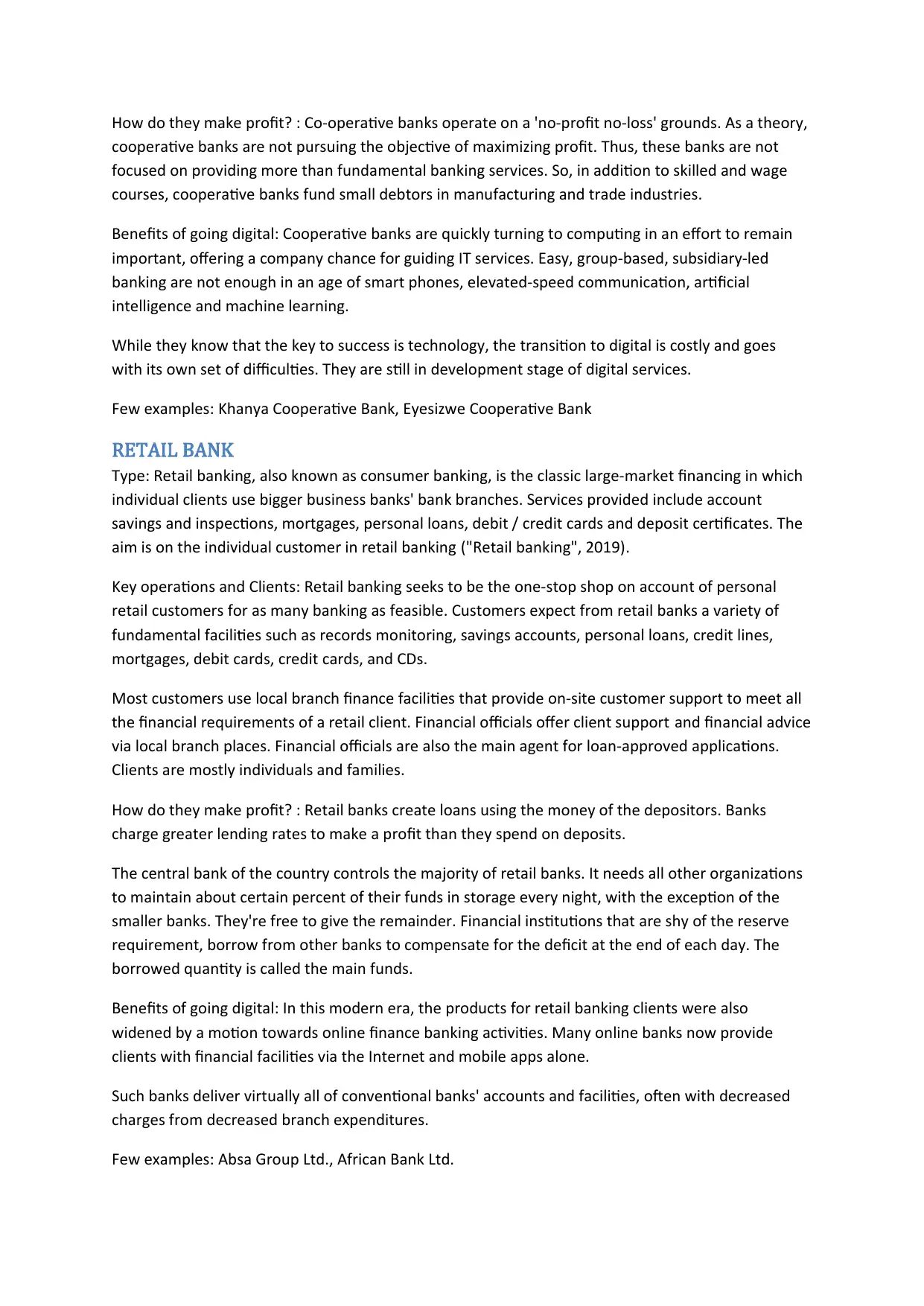
How do they make profit? : Co-operative banks operate on a 'no-profit no-loss' grounds. As a theory,
cooperative banks are not pursuing the objective of maximizing profit. Thus, these banks are not
focused on providing more than fundamental banking services. So, in addition to skilled and wage
courses, cooperative banks fund small debtors in manufacturing and trade industries.
Benefits of going digital: Cooperative banks are quickly turning to computing in an effort to remain
important, offering a company chance for guiding IT services. Easy, group-based, subsidiary-led
banking are not enough in an age of smart phones, elevated-speed communication, artificial
intelligence and machine learning.
While they know that the key to success is technology, the transition to digital is costly and goes
with its own set of difficulties. They are still in development stage of digital services.
Few examples: Khanya Cooperative Bank, Eyesizwe Cooperative Bank
RETAIL BANK
Type: Retail banking, also known as consumer banking, is the classic large-market financing in which
individual clients use bigger business banks' bank branches. Services provided include account
savings and inspections, mortgages, personal loans, debit / credit cards and deposit certificates. The
aim is on the individual customer in retail banking ("Retail banking", 2019).
Key operations and Clients: Retail banking seeks to be the one-stop shop on account of personal
retail customers for as many banking as feasible. Customers expect from retail banks a variety of
fundamental facilities such as records monitoring, savings accounts, personal loans, credit lines,
mortgages, debit cards, credit cards, and CDs.
Most customers use local branch finance facilities that provide on-site customer support to meet all
the financial requirements of a retail client. Financial officials offer client support and financial advice
via local branch places. Financial officials are also the main agent for loan-approved applications.
Clients are mostly individuals and families.
How do they make profit? : Retail banks create loans using the money of the depositors. Banks
charge greater lending rates to make a profit than they spend on deposits.
The central bank of the country controls the majority of retail banks. It needs all other organizations
to maintain about certain percent of their funds in storage every night, with the exception of the
smaller banks. They're free to give the remainder. Financial institutions that are shy of the reserve
requirement, borrow from other banks to compensate for the deficit at the end of each day. The
borrowed quantity is called the main funds.
Benefits of going digital: In this modern era, the products for retail banking clients were also
widened by a motion towards online finance banking activities. Many online banks now provide
clients with financial facilities via the Internet and mobile apps alone.
Such banks deliver virtually all of conventional banks' accounts and facilities, often with decreased
charges from decreased branch expenditures.
Few examples: Absa Group Ltd., African Bank Ltd.
cooperative banks are not pursuing the objective of maximizing profit. Thus, these banks are not
focused on providing more than fundamental banking services. So, in addition to skilled and wage
courses, cooperative banks fund small debtors in manufacturing and trade industries.
Benefits of going digital: Cooperative banks are quickly turning to computing in an effort to remain
important, offering a company chance for guiding IT services. Easy, group-based, subsidiary-led
banking are not enough in an age of smart phones, elevated-speed communication, artificial
intelligence and machine learning.
While they know that the key to success is technology, the transition to digital is costly and goes
with its own set of difficulties. They are still in development stage of digital services.
Few examples: Khanya Cooperative Bank, Eyesizwe Cooperative Bank
RETAIL BANK
Type: Retail banking, also known as consumer banking, is the classic large-market financing in which
individual clients use bigger business banks' bank branches. Services provided include account
savings and inspections, mortgages, personal loans, debit / credit cards and deposit certificates. The
aim is on the individual customer in retail banking ("Retail banking", 2019).
Key operations and Clients: Retail banking seeks to be the one-stop shop on account of personal
retail customers for as many banking as feasible. Customers expect from retail banks a variety of
fundamental facilities such as records monitoring, savings accounts, personal loans, credit lines,
mortgages, debit cards, credit cards, and CDs.
Most customers use local branch finance facilities that provide on-site customer support to meet all
the financial requirements of a retail client. Financial officials offer client support and financial advice
via local branch places. Financial officials are also the main agent for loan-approved applications.
Clients are mostly individuals and families.
How do they make profit? : Retail banks create loans using the money of the depositors. Banks
charge greater lending rates to make a profit than they spend on deposits.
The central bank of the country controls the majority of retail banks. It needs all other organizations
to maintain about certain percent of their funds in storage every night, with the exception of the
smaller banks. They're free to give the remainder. Financial institutions that are shy of the reserve
requirement, borrow from other banks to compensate for the deficit at the end of each day. The
borrowed quantity is called the main funds.
Benefits of going digital: In this modern era, the products for retail banking clients were also
widened by a motion towards online finance banking activities. Many online banks now provide
clients with financial facilities via the Internet and mobile apps alone.
Such banks deliver virtually all of conventional banks' accounts and facilities, often with decreased
charges from decreased branch expenditures.
Few examples: Absa Group Ltd., African Bank Ltd.
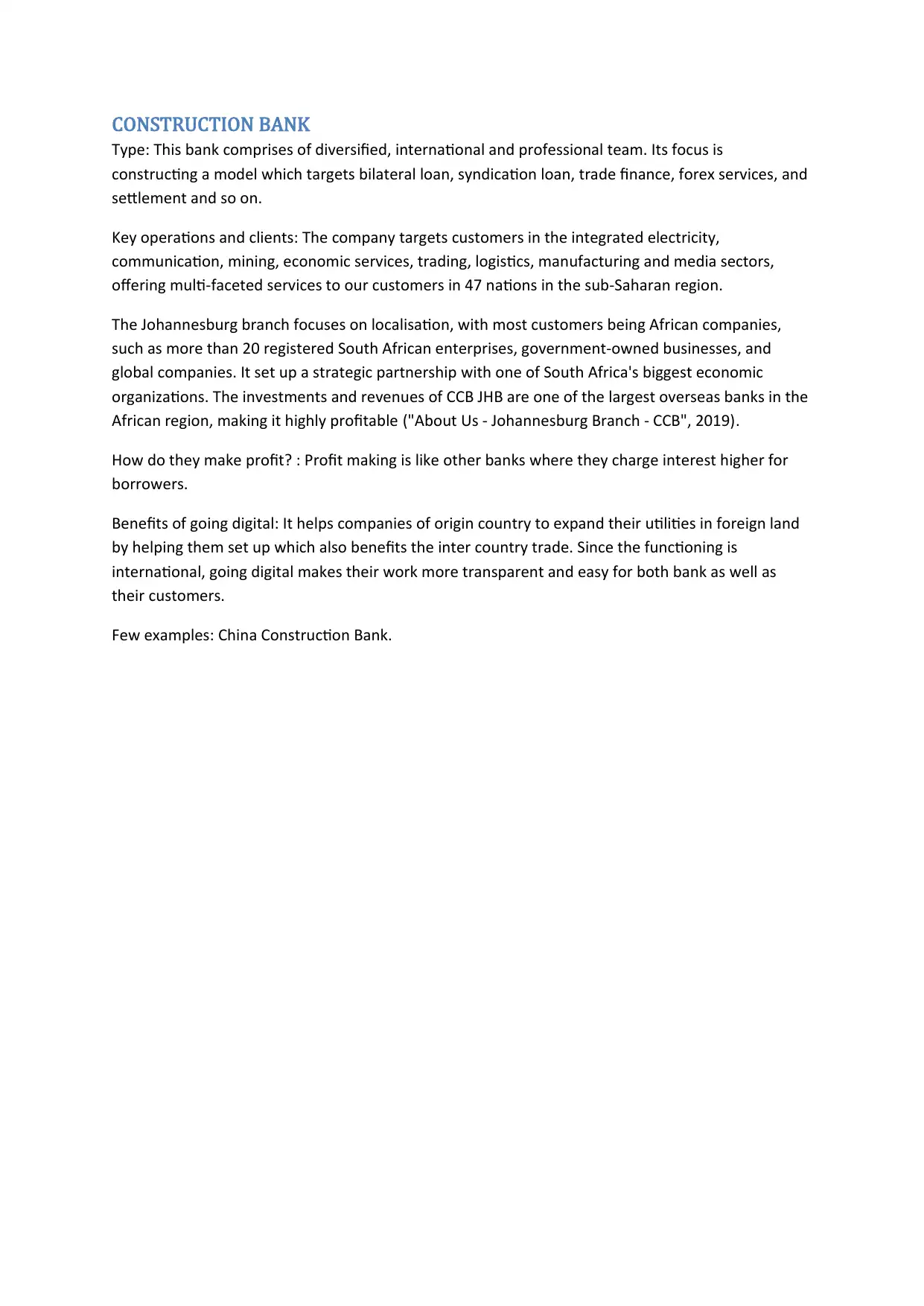
CONSTRUCTION BANK
Type: This bank comprises of diversified, international and professional team. Its focus is
constructing a model which targets bilateral loan, syndication loan, trade finance, forex services, and
settlement and so on.
Key operations and clients: The company targets customers in the integrated electricity,
communication, mining, economic services, trading, logistics, manufacturing and media sectors,
offering multi-faceted services to our customers in 47 nations in the sub-Saharan region.
The Johannesburg branch focuses on localisation, with most customers being African companies,
such as more than 20 registered South African enterprises, government-owned businesses, and
global companies. It set up a strategic partnership with one of South Africa's biggest economic
organizations. The investments and revenues of CCB JHB are one of the largest overseas banks in the
African region, making it highly profitable ("About Us - Johannesburg Branch - CCB", 2019).
How do they make profit? : Profit making is like other banks where they charge interest higher for
borrowers.
Benefits of going digital: It helps companies of origin country to expand their utilities in foreign land
by helping them set up which also benefits the inter country trade. Since the functioning is
international, going digital makes their work more transparent and easy for both bank as well as
their customers.
Few examples: China Construction Bank.
Type: This bank comprises of diversified, international and professional team. Its focus is
constructing a model which targets bilateral loan, syndication loan, trade finance, forex services, and
settlement and so on.
Key operations and clients: The company targets customers in the integrated electricity,
communication, mining, economic services, trading, logistics, manufacturing and media sectors,
offering multi-faceted services to our customers in 47 nations in the sub-Saharan region.
The Johannesburg branch focuses on localisation, with most customers being African companies,
such as more than 20 registered South African enterprises, government-owned businesses, and
global companies. It set up a strategic partnership with one of South Africa's biggest economic
organizations. The investments and revenues of CCB JHB are one of the largest overseas banks in the
African region, making it highly profitable ("About Us - Johannesburg Branch - CCB", 2019).
How do they make profit? : Profit making is like other banks where they charge interest higher for
borrowers.
Benefits of going digital: It helps companies of origin country to expand their utilities in foreign land
by helping them set up which also benefits the inter country trade. Since the functioning is
international, going digital makes their work more transparent and easy for both bank as well as
their customers.
Few examples: China Construction Bank.
⊘ This is a preview!⊘
Do you want full access?
Subscribe today to unlock all pages.

Trusted by 1+ million students worldwide
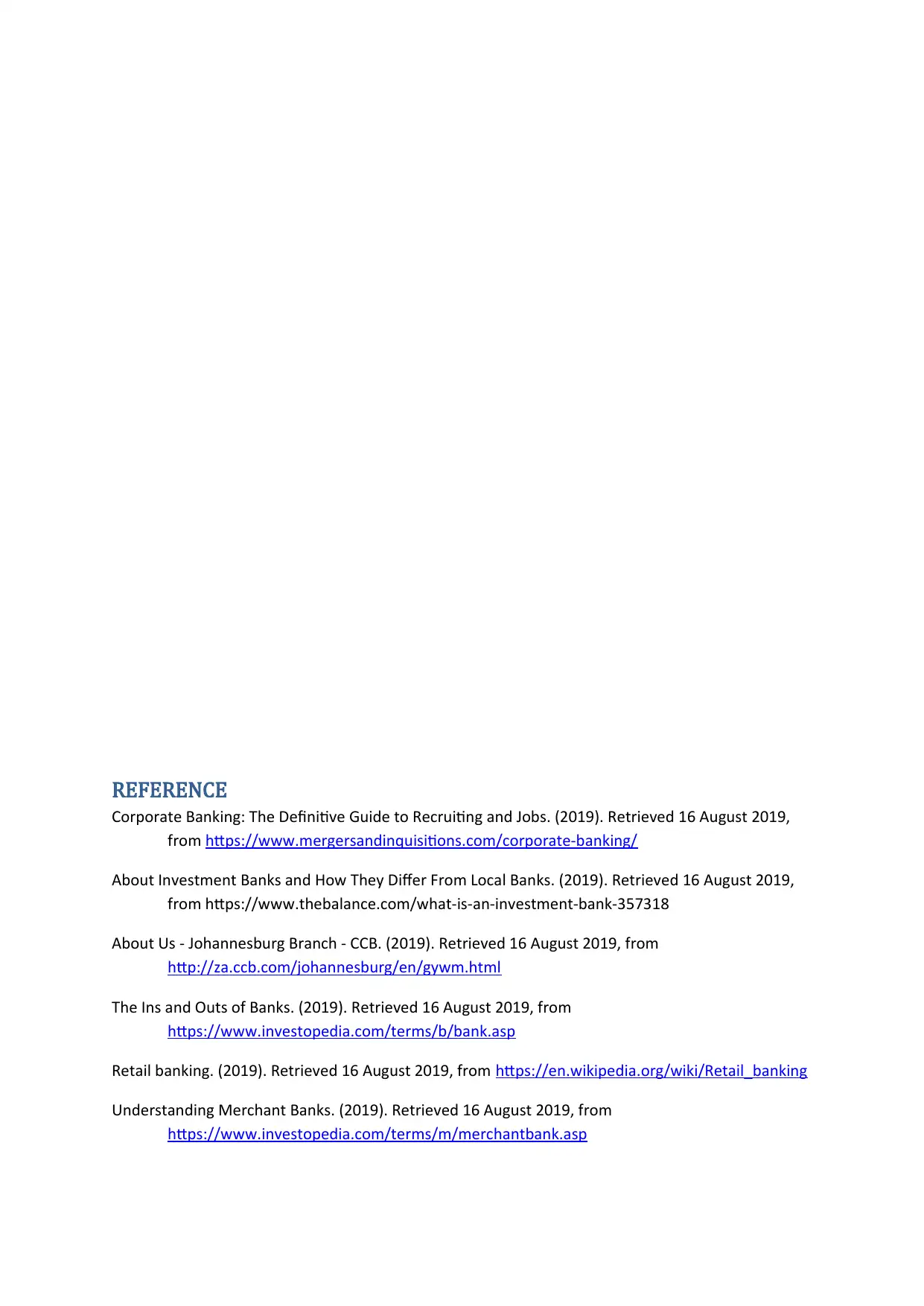
REFERENCE
Corporate Banking: The Definitive Guide to Recruiting and Jobs. (2019). Retrieved 16 August 2019,
from https://www.mergersandinquisitions.com/corporate-banking/
About Investment Banks and How They Differ From Local Banks. (2019). Retrieved 16 August 2019,
from https://www.thebalance.com/what-is-an-investment-bank-357318
About Us - Johannesburg Branch - CCB. (2019). Retrieved 16 August 2019, from
http://za.ccb.com/johannesburg/en/gywm.html
The Ins and Outs of Banks. (2019). Retrieved 16 August 2019, from
https://www.investopedia.com/terms/b/bank.asp
Retail banking. (2019). Retrieved 16 August 2019, from https://en.wikipedia.org/wiki/Retail_banking
Understanding Merchant Banks. (2019). Retrieved 16 August 2019, from
https://www.investopedia.com/terms/m/merchantbank.asp
Corporate Banking: The Definitive Guide to Recruiting and Jobs. (2019). Retrieved 16 August 2019,
from https://www.mergersandinquisitions.com/corporate-banking/
About Investment Banks and How They Differ From Local Banks. (2019). Retrieved 16 August 2019,
from https://www.thebalance.com/what-is-an-investment-bank-357318
About Us - Johannesburg Branch - CCB. (2019). Retrieved 16 August 2019, from
http://za.ccb.com/johannesburg/en/gywm.html
The Ins and Outs of Banks. (2019). Retrieved 16 August 2019, from
https://www.investopedia.com/terms/b/bank.asp
Retail banking. (2019). Retrieved 16 August 2019, from https://en.wikipedia.org/wiki/Retail_banking
Understanding Merchant Banks. (2019). Retrieved 16 August 2019, from
https://www.investopedia.com/terms/m/merchantbank.asp
Paraphrase This Document
Need a fresh take? Get an instant paraphrase of this document with our AI Paraphraser

Postal savings system. (2019). Retrieved 16 August 2019, from
https://en.wikipedia.org/wiki/Postal_savings_system
https://en.wikipedia.org/wiki/Postal_savings_system
1 out of 8
Related Documents
Your All-in-One AI-Powered Toolkit for Academic Success.
+13062052269
info@desklib.com
Available 24*7 on WhatsApp / Email
![[object Object]](/_next/static/media/star-bottom.7253800d.svg)
Unlock your academic potential
Copyright © 2020–2025 A2Z Services. All Rights Reserved. Developed and managed by ZUCOL.




